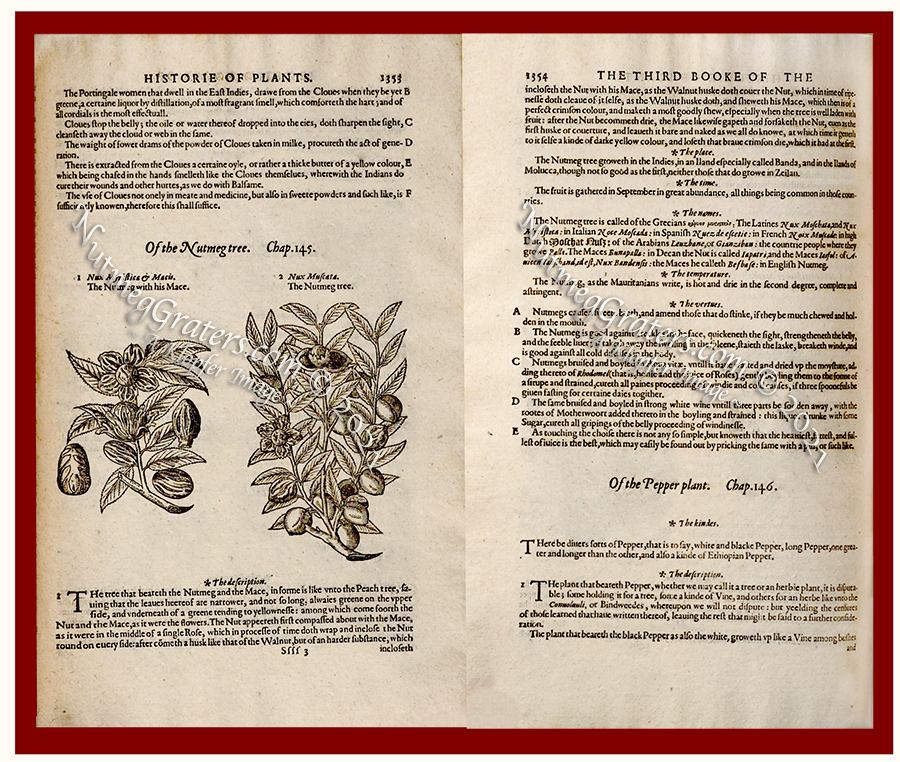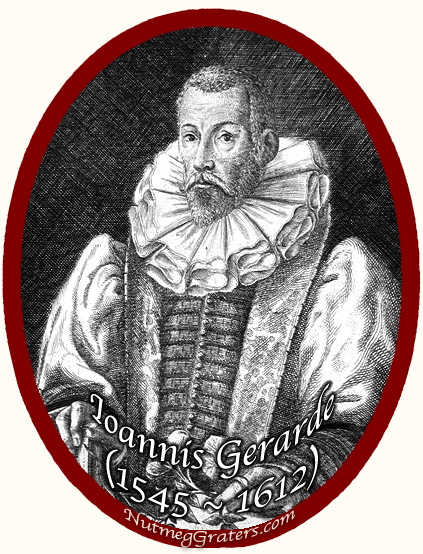NutmegGraters.Com


 Chapter 145. Of the Nutmeg tree.
Chapter 145. Of the Nutmeg tree.
"1 The Nutmeg with his Mace."
"2 The Nutmeg tree."
~ 1597 ~ Gerarde ~ The Herball Or Generall Historie of Plantes
PRINTS: 1. Nux Myriʃtica & Macis. The Nutmeg with his Mace. | 2. Nux Muʃcata. The Nutmeg Tree.
TEXT TITLE: Chap 145. Of the Nutmeg tree. (Pages 1353 - 1354).
SOURCE: The Herball Or Generall Historie of Plantes. Gathered by Iohn Gerarde of London
Master in Chirurgerie. The Third Booke Of The Historie Of Plants.
AUTHOR / EDITOR / CREATOR: John Gerarde.
PUBLISHER: John Norton, London.
DATE OF PUBLICATION: 1597 Edition.
SCOPE AND PURPOSE OF PUBLICATION: This is a medical herbal text.
PRINT METHOD: Xylography (wood block printing) uncolored.
PAPER TYPE: Chain Laid Paper without watermarks;
sheet size W. 8½" (21.5 cm) x L. 12½" (31.75 cm).
HISTORY:
[The Herball Or Generall Historie of Plantes (PART 1: 1597 / PART 2: 1636) ]
More than 1000 plants are detailed in Joannis Gerarde's (1545~1612) first edition of The Herball Or Generall Historie of Plants, published in 1596. Gerarde was not the originator in this project, but instead, a later appointee replacement, completing the publication after the death of its initial creator, Dr. Robert Priest. It is well documented that among its monumental 1484 pages, The Herball Or Generall Historie of Plants reused nearly two thousand woodblocks obtained from Nicolaus Bassaeus of Frankfurt, Germany; as well as text from others: including those from early 16th century works by Dodoens, Fuchs, Brunsels, L'Obel, Matthiollus, and Clusius. Some accused Gerarde of plagiarism, claiming that he simply translated, reedited and combined two earlier publications by Rembert Dodoens (1517~1585): Cruydteboeck [Histoire Des Plantes] (1554) and Stirpium Historiae Pemptades Sex (1583). Reportedly, Gerarde lacked horticultural expertise resulting in copious errors within his original proof. To rectify this prior to its issuing, the publisher (John Norton) secretly hired Matthias de L'Obel, a globally recognized herbal expert. L'Obel was engaged to correctly sort and match illustrations with their accurate text blocks, and to correct horticultural fact from folklore myths. It is reported that when Gerarde discovered L'Obel's involvement, L'Obel was fired. In spite of its countless errors, The Herball Or Generall Historie of Plants was relied upon as a primary source of its time.
For Additional Information SEE:
̊ ̊ ̊ John Gerard, Wikipedia, Wikimedia Foundation, 23 November 2020.
INACCURACIES:
Spurious Description:
The text in Gerarde's Chapter 145. Of the Nutmeg tree is largely spurious in detail, providing only meager factually correct information. This limited fact-based knowledge seems based on inaccurate assumptions of this era. The text reads:
✽ The deʃcription.
The Nut appeereth firſt compaʃʃed about the Mace, as it were in the middle of a ʃingle
Roʃe, which in proceʃʃe of time doth wrap and incloʃe the Nut round on every ʃide: after
cõmeth a husk like that of the Walnut, but of an harder ʃubʃtance, which incloʃeth the Nut
with his Mace, as the Walnut husky doth cover the Nut, which in time of ripeneʃʃe, as the
Walnut husky doth, and ʃheweth his Mace, which then is of a perfeƈt crimʃon colour, and
taketh a moʃt goodly ʃhew, eʃpecially when the tree is well laden with fruit :" …
✽ The time.
The fruit is gathered in September in great abundance, all things being common in thoʃe
countries.
Other than describing that Mace is "crimson" in color, the remaining text is spurious in detail. Accurately, nutmeg is the seed that grows inside the fruit. At all times throughout the year, the "round nutmeg" Myristica Moschata of the Banda Islands is ever-bearing, with a female tree simultaneously in flower, in both its early and late stages of fruitation, and with nutmeg/mace ever ready for harvest. There is no mention that this species requires both a male and female tree to bear fruit. Further, it is only for practical reasons that nutmeg is harvested at the convenience of its growers, usually three times a year.
Spurious Illustrations:
̊ ̊ ̊ Wikipedia reports that the woodblock images used within Gerarde's The Herball Or Generall Historie of Plants were reused items, hired from Nicolaus Bassaeus of Frankfurt. A review of the larger 16th century herbal literature finds that these woodblock images take after earlier works by Petrus Andreas Matthiollus. The "1. Nux Myriʃtica & Macis. The Nutmeg with his Mace." image resembles Matthiollus' image from: Commentaire sur les six livres de Ped. Dioscor. Anazarbeen de la matière, Page 184, (1579), while "2. Nux Muʃcata. The Nutmeg Tree." mimics Matthiollus' image from: Senensis Medici, Commentarii in ʃex libros Pedacii Dioscoridis Anazarbei de Medica materia, Iam DenUo Ab Ipso Autore Recogniti Et Locis Plus Mille Aucti, Page 278, (1565).
The woodblock images used by Gerarde are highly inaccurate. Notice that the actual flowers (shown above right) are tiny white buds found on an actual female nutmeg tree. Gerarde (Fig 1) incorrectly depicts large, billowing flowers which are complete fabrications by a woodblock artisan. Depiction of these over-sized flowers are also seen among other engravings by European artists of the late seventeenth century. Nutmeg is the seed inside a yellow peach size fruit, which when ripened splits open to reveal the crimson aerial (mace) surrounding the husked nutmeg seed; although this is somewhat accurately shown (Fig 2), the correct description of the fruit is nowhere reported within Gerarde's text. The same sized depiction of the adjacent fruit with the imagined nutmeg enveloped by its mace (Fig 3) are of factitious fabrication. A factual image would illustrate simultaneous development with all the stages of fruit ~ from tiny flowers to fully ripened; being year round.
[KLOPFER article © January 2021 ]